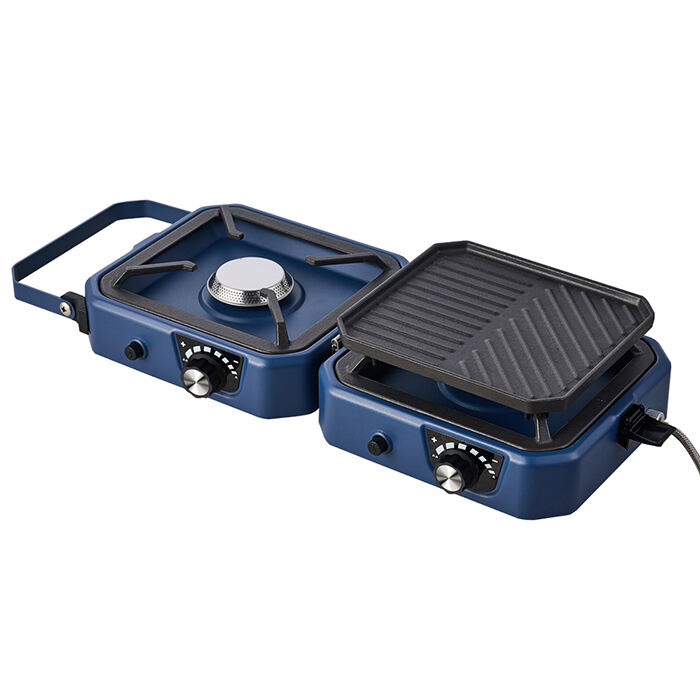How Does a Camping Gas Stove Improve Your Camping Experience?
Modern outdoor enthusiasts recognize that having reliable cooking equipment can transform a basic camping trip into a memorable culinary adventure. A quality camping gas stove serves as the cornerstone of outdoor cooking, providing consistent heat, precise temperature control, and the convenience necessary for preparing satisfying meals in the wilderness. Unlike traditional campfire cooking methods, gas stoves offer predictable performance regardless of weather conditions, making them an essential piece of equipment for serious campers who refuse to compromise on meal quality during their outdoor excursions.

Enhanced Cooking Efficiency and Control
Instant Heat Generation
The most significant advantage of a camping gas stove lies in its ability to provide immediate heat without the lengthy preparation required for traditional campfires. Within seconds of ignition, you can achieve the precise temperature needed for various cooking techniques, from gentle simmering to high-heat searing. This instant responsiveness allows campers to maximize their time enjoying nature rather than spending precious daylight hours collecting firewood and waiting for coals to reach optimal cooking temperatures.
Professional outdoor chefs and seasoned campers consistently praise gas stoves for their reliability in diverse weather conditions. Rain, wind, and high altitude environments that would make campfire cooking nearly impossible pose minimal challenges to a well-designed gas stove system. The enclosed flame design protects against wind interference, while the consistent fuel delivery ensures stable performance regardless of external atmospheric pressures.
Precise Temperature Management
Temperature control represents another crucial advantage that elevates the camping cooking experience. Unlike campfires where heat management requires constant attention and repositioning of cookware, gas stoves offer dial-controlled flame adjustment that allows for precise cooking techniques. This level of control enables outdoor enthusiasts to prepare complex meals that require specific temperature ranges, from delicate sauces that need gentle warming to proteins requiring high-heat searing for optimal flavor development.
The ability to instantly adjust flame intensity means you can respond immediately to changing cooking requirements without the lengthy wait times associated with traditional fire management. This responsiveness proves particularly valuable when preparing time-sensitive dishes or when cooking for larger groups where timing coordination becomes critical for serving hot, properly prepared meals simultaneously.
Convenience and Practical Benefits
Compact Design and Portability
Modern camping gas stove designs prioritize portability without sacrificing performance, making them ideal companions for various outdoor activities ranging from backpacking expeditions to car camping adventures. Lightweight materials and folding designs allow these stoves to fit easily into backpacks or camping gear storage, while their compact footprint means they occupy minimal space in already limited camping setups. This space efficiency becomes particularly important during multi-day hiking trips where every ounce of carried weight matters.
The portability factor extends beyond mere weight considerations to include setup simplicity and operational convenience. Most quality gas stoves require no assembly beyond unfolding legs or attaching fuel canisters, allowing campers to begin cooking within minutes of arrival at their campsite. This quick deployment capability proves invaluable during weather emergencies or when setting up camp in low-light conditions where traditional fire-building would be challenging or dangerous.
Clean and Efficient Operation
A camping gas stove produces minimal smoke and ash compared to wood-burning alternatives, creating a more pleasant cooking environment and reducing the cleaning requirements for both cookware and surrounding areas. This cleaner operation means less time spent on post-meal cleanup and reduced risk of food contamination from ash or debris. The absence of smoke also makes cooking more comfortable for individuals with respiratory sensitivities while preventing the persistent smoky odor that often accompanies campfire cooking.
Environmental benefits accompany the cleaner operation characteristics, as gas stoves eliminate the need for collecting local firewood, helping preserve natural ecosystems and reducing human impact on camping areas. This eco-friendly approach aligns with Leave No Trace principles that responsible outdoor enthusiasts embrace to protect wilderness areas for future generations.
Versatility in Outdoor Cooking Applications
Multi-Cooking Technique Capabilities
The consistent heat output of camping gas stove systems enables a wide range of cooking methods that would be difficult or impossible to achieve with traditional campfire approaches. Sautéing vegetables, creating reduction sauces, preparing delicate fish dishes, and even baking with appropriate accessories become feasible options that expand the culinary possibilities during outdoor adventures. This versatility transforms camping meals from basic sustenance into enjoyable dining experiences that rival home-cooked meals.
Professional outdoor guides often rely on gas stoves to demonstrate advanced cooking techniques to their clients, knowing that the predictable performance allows for successful execution of complex recipes even in challenging outdoor environments. The ability to maintain consistent low heat for extended periods enables slow-cooking methods, while rapid heat adjustment facilitates techniques requiring quick temperature changes, such as stir-frying or flambéing.
Adaptability to Various Cookware
Unlike campfires that limit cookware options to heavy-duty cast iron or specialized camping equipment, gas stoves accommodate a broader range of cooking vessels, including lightweight aluminum pots, stainless steel pans, and even some ceramic cookware designed for outdoor use. This compatibility allows campers to bring familiar cooking equipment from home, making meal preparation more intuitive and successful while reducing the learning curve associated with specialized campfire cooking gear.
The stable, level cooking surface provided by most camping gas stove designs ensures even heat distribution across cookware bottoms, preventing hot spots that could burn food or cause uneven cooking results. This consistency proves particularly important when preparing meals for groups where uniform cooking quality across multiple portions becomes essential for successful outdoor dining experiences.
Safety and Reliability Considerations
Reduced Fire Hazards
Operating a camping gas stove significantly reduces the risk of accidental wildfires compared to open campfire cooking, making it a responsible choice in dry conditions or fire-restricted areas. The contained flame design and instant shut-off capabilities provide users with complete control over ignition sources, while built-in safety features in quality stoves include automatic shut-off valves and flame failure protection systems that enhance overall operational safety.
Emergency response capabilities represent another safety advantage, as gas stoves can be extinguished immediately in crisis situations, unlike campfires that require time and resources to fully extinguish. This rapid response capability proves crucial in windy conditions or when unexpected weather changes create potentially dangerous fire conditions that require immediate flame elimination.
Consistent Performance Reliability
Weather independence makes camping gas stove systems reliable cooking solutions regardless of environmental conditions that would prevent traditional fire-building activities. Heavy rain, snow, or extreme wind conditions that would make campfire maintenance impossible have minimal impact on gas stove operation, ensuring that campers can prepare hot meals and beverages when they need them most for comfort and safety during challenging weather periods.
Fuel availability and storage advantages contribute to long-term reliability during extended camping trips. Gas canisters provide predictable burn times and can be stored safely for extended periods without degradation, unlike firewood that may become damp or difficult to ignite after exposure to moisture. This reliability factor proves especially important during winter camping or in regions where dry firewood may be scarce or unavailable.
FAQ
What types of fuel do camping gas stoves typically use
Most camping gas stoves operate on either butane, propane, or mixed fuel canisters, with each type offering specific advantages for different camping conditions. Butane performs well in moderate temperatures but can struggle in cold weather, while propane maintains consistent pressure in lower temperatures, making it ideal for winter camping or high-altitude adventures.
How long does a typical gas canister last during camping trips
A standard camping gas stove canister typically provides 2-4 hours of burn time depending on flame intensity and stove efficiency, which translates to approximately 4-8 meals for average camping cooking needs. Factors such as wind conditions, cookware type, and cooking methods can significantly impact fuel consumption rates.
Can camping gas stoves be used safely inside tents or enclosed spaces
Camping gas stoves should never be used inside tents or poorly ventilated enclosed spaces due to carbon monoxide risks and fire hazards. Always operate gas stoves in well-ventilated outdoor areas, maintaining adequate clearance from flammable materials and ensuring proper ventilation to prevent dangerous gas accumulation.
What maintenance requirements do camping gas stoves have for optimal performance
Regular maintenance includes cleaning burner ports to prevent clogging, checking fuel connections for leaks, and storing the stove in dry conditions to prevent corrosion. Periodic inspection of rubber seals and connections ensures safe operation, while following manufacturer guidelines for cleaning and storage extends equipment lifespan significantly.







